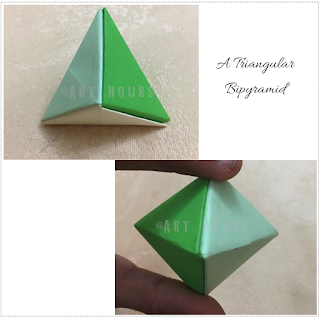The last few months have been a great journey while we explored the world of 3D and modular origami. In the process, we discovered beautiful models designed by several origami artists around the world. Most popular is, of course, the Sonobe model. On digging out the internet we found that their origin is still unknown. Two of the possible creators could be Toshie Takohama and Mitsunobu Sonobe, who have published several books together and are members of the Origami Group.
The beauty of the Sonobe unit lies in its flexibility to combine in several different combinations that can be used to build a simple triangular bipyramid, cube, trisoctahedron to many complicated polyhedrons. Origami artists around the world have experimented with this basic unit and have built several variations using the same unit.
 |
| Sonobe Unit: Picture Tutorial by Art Hours |
The model made of three units results in a triangular bipyramid. Using six units results in a cube. Using twelve Sonobe units, results in a triakis octahedron. Using 30 units you can make a triakis icosahedron.
Here's a picture of a bipyramid (also called a dipyramid) that was built using 3 Sonobe units. Only 3 units were used to build the bipyramid which has 6 triangular faces and hence can also be called a hexahedron.
 |
| A Triangular Bipyramid using 3 sonobe units |
Below is a picture of a cube that was built using 6 nos. of Sonobe units. This one has six square faces as visible in the picture.
 |
| Origami Cube using 6 Sonobe units |
We found several models of the Sonobe on the internet and had fun building models from different types of variations. Below is a picture of a Trisoctahedron we built using 12 units of the Sonobe unit but its a slightly different variation of the Sonobe unit. The shape that resulted is actually an octahedron with triangular pyramids added on its every face. So, it has 8 extreme ends or tips and each tip has 3 triangular faces. Totally, it has 24 triangular faces.
We used magazine paper to build the model...one way of putting magazine paper to good use instead of throwing them away, and after all, recycling is the buzzword nowadays!
 |
| Trisoctahedron made from 12 units - variation of Sonobe unit |
Here are two more models using the same variation of Sonobe unit used above for the trisoctahedron. The cube was made using 6 units and the Triambic Icosahedron was made using 30 units.
 |
| Left Front: Cube using 6 units Right Back: Triambic Icosahedron using 30 units |
We tried out several other variations too. Below is something splendid we tried using other variations developed by Maria Sinayskaya. She calls it the Rose Kusudama. You will find the model diagrams on her website. By the way kusudama is a Japanese word which means medicine balls (kusuri means medicine and tama means a ball in Japanese). They were used for incense and potpourri; nowadays typically used as decorations or gifts.
The first model you see in the picture below is a yellow rose kusudama, made from 12 nos. of 1:2 rectangular sheets. The second model is a pink rose kusudama, made from 12 nos. square sheets. Personally, I loved the second model, as it turns out to be a sturdy one.
 |
| Rose Kusudama using 12 nos. 1:2 Rectangular sheet |
 |
| Rose Kusudama using 12 nos. Square sheet |
We are still exploring many other origami models and designing our own variations too.
Our journey is Origami is getting interesting day by day...keep visiting us more often to learn and explore the art world.
Stay with us, learn, like and share. Your valuable comments and feedback are welcome.
Follow us on Instagram to explore what we are working on currently: www.instagram.com/archguide16 or stop by our FB page:fb.me/arthours to explore our tutorials and student workshops.
Follow us on Instagram to explore what we are working on currently: www.instagram.com/archguide16 or stop by our FB page:fb.me/arthours to explore our tutorials and student workshops.
Thank you for stopping by.
Have a good day...
---

No comments:
Post a Comment